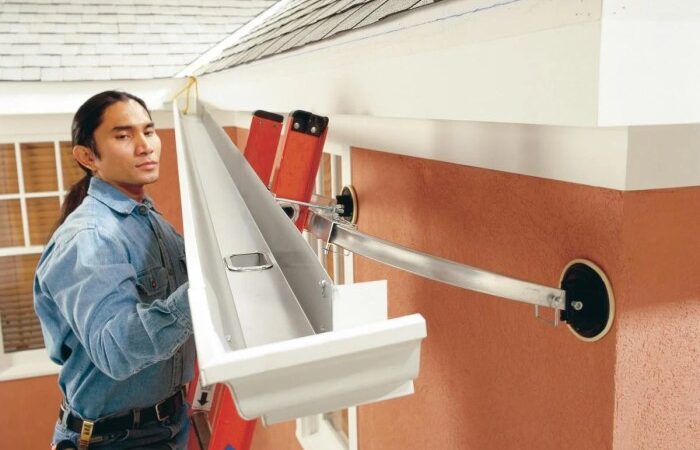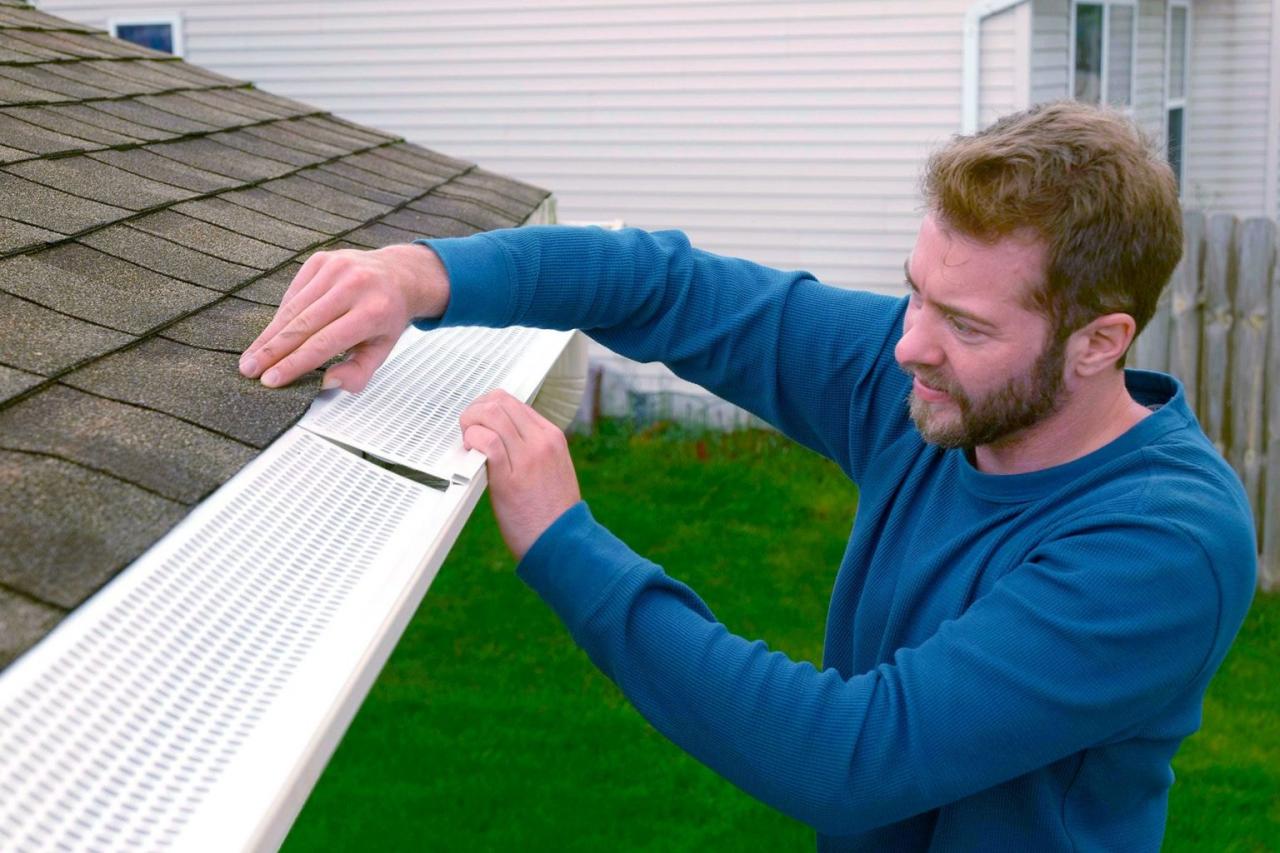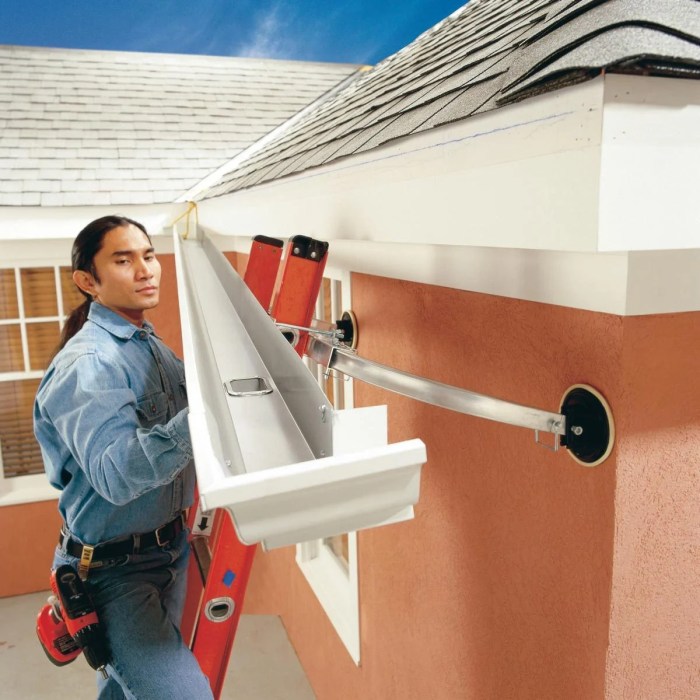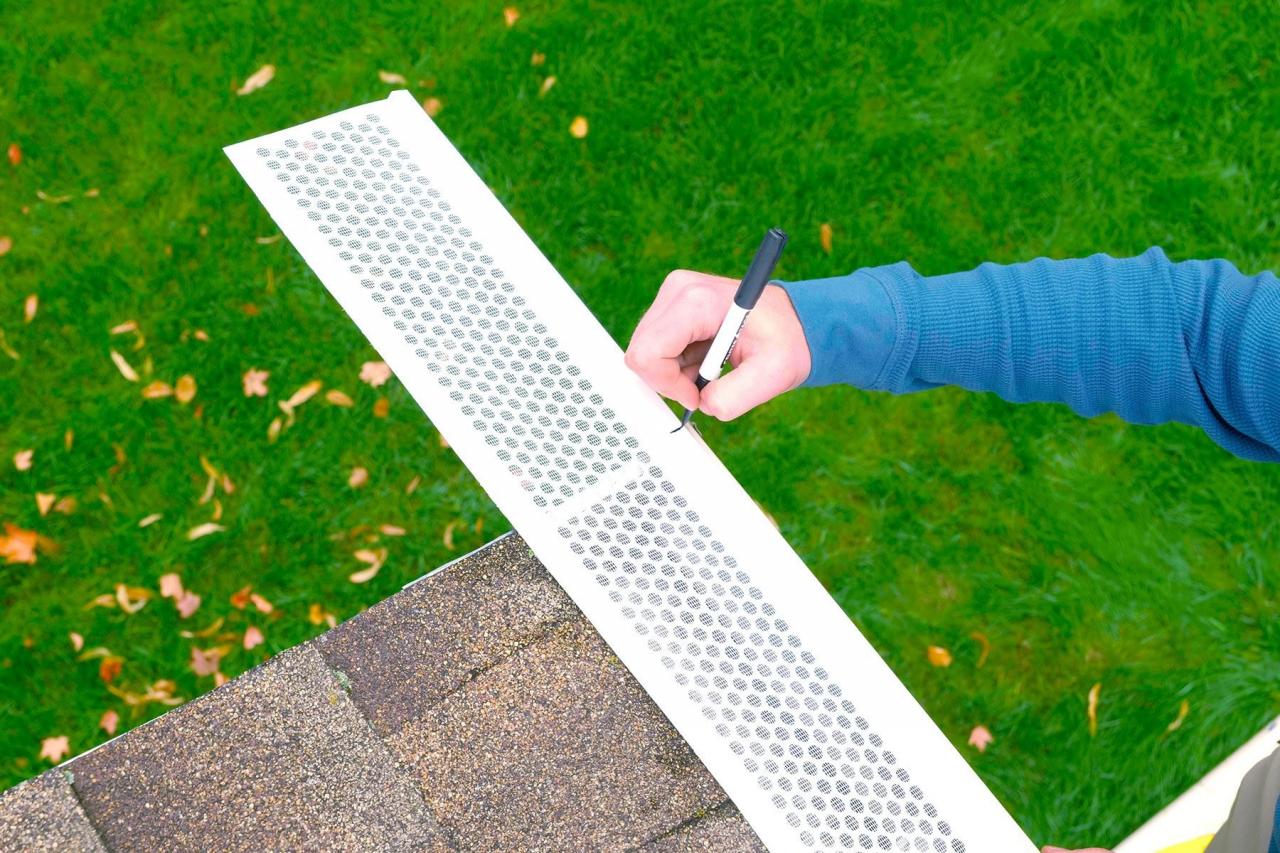Handyman to Install Gutter Guards: Protecting Your Home

Handyman to install gutter guards sets the stage for this enthralling narrative, offering readers a glimpse into a story that is rich in detail and brimming with originality from the outset. Gutter guards are a valuable investment for homeowners, offering protection against clogged gutters, water damage, and other potential problems.
Whether you’re a DIY enthusiast or prefer the expertise of a professional, understanding the benefits and considerations of gutter guards is essential for maintaining a healthy and safe home.
This guide explores the various aspects of gutter guards, from their types and benefits to installation options and cost considerations. We’ll delve into the advantages and disadvantages of DIY installation versus hiring a professional handyman, and provide valuable tips for finding a reliable and experienced contractor.
By the end, you’ll be equipped with the knowledge and resources to make an informed decision about gutter guards for your home.
The Importance of Gutter Guards
Gutter guards are essential for maintaining the health and integrity of your home’s roof and foundation. By preventing debris from accumulating in your gutters, gutter guards help to ensure proper water drainage, protecting your home from potential damage.
Problems Associated with Clogged Gutters, Handyman to install gutter guards
Clogged gutters can lead to a variety of problems that can be costly to repair. When leaves, twigs, and other debris accumulate in your gutters, they can block the flow of water, causing it to overflow and damage your home.
- Water Damage: Overflowing gutters can cause water to seep into your home’s foundation, leading to structural damage, mold growth, and even foundation cracks.
- Foundation Issues: The constant saturation of soil around your home’s foundation due to overflowing gutters can weaken the foundation and lead to settling or even collapse.
- Pest Infestations: Clogged gutters provide a breeding ground for insects and rodents, which can then find their way into your home.
Types of Gutter Guards
There are many different types of gutter guards available on the market, each with its advantages and disadvantages. Here are some of the most common types:
- Mesh Gutter Guards: These guards are made from a fine mesh material that allows water to pass through while blocking debris. Mesh guards are generally effective and affordable, but they can sometimes become clogged with small debris like pine needles.
- Screen Gutter Guards: Similar to mesh guards, screen guards use a coarser material that can handle larger debris. They are typically more durable than mesh guards but may not be as effective at blocking smaller debris.
- Foam Gutter Guards: Foam guards are designed to absorb water and allow it to drain through small holes. They are generally effective at blocking debris, but they can become compacted over time and may need to be replaced.
Choosing the Right Gutter Guards

Choosing the right gutter guards is essential to ensure they effectively protect your gutters and prevent clogs. Consider factors like the type of roof, climate, budget, and maintenance requirements. Here’s a breakdown of common gutter guard options to help you make the best decision.
Types of Gutter Guards
- Brush Guards: These are made of a simple brush of bristles that sit on top of the gutter, allowing water to flow through while blocking debris. They are inexpensive and easy to install, but they can be prone to clogging and require regular cleaning.
- Screen Guards: Screen guards are made of fine mesh that allows water to pass through while preventing leaves and other debris from entering the gutter. They are more effective than brush guards but can become clogged with smaller debris, such as pine needles or seeds.
- Solid Gutter Guards: Solid gutter guards are made of a solid material, such as aluminum or vinyl, that covers the entire gutter. They are very effective at preventing clogs, but they can be more expensive and may require professional installation.
- Micro-Mesh Gutter Guards: Micro-mesh gutter guards are made of a very fine mesh that allows water to pass through while blocking even the smallest debris. They are highly effective and require minimal maintenance. However, they can be more expensive than other options.
Factors to Consider When Choosing Gutter Guards
- Roof Type: If you have a roof with a steep pitch, you may want to consider gutter guards that are designed to handle high volumes of water. For roofs with a low pitch, you may need a gutter guard that can prevent clogging from smaller debris.
- Climate: In areas with heavy rainfall, you may need gutter guards that are designed to handle high volumes of water. In areas with high winds, you may need gutter guards that are securely attached to the gutter.
- Budget: Gutter guards vary in price, so it is important to consider your budget when making your decision. Brush guards are the most affordable option, while solid gutter guards are the most expensive.
- Maintenance Requirements: Some gutter guards require more maintenance than others. For example, brush guards need to be cleaned regularly to prevent clogging, while solid gutter guards require minimal maintenance.
Comparison Table
| Gutter Guard Type | Pros | Cons |
|---|---|---|
| Brush Guards | Inexpensive, easy to install | Prone to clogging, requires regular cleaning |
| Screen Guards | More effective than brush guards, relatively inexpensive | Can become clogged with smaller debris |
| Solid Gutter Guards | Very effective at preventing clogs, low maintenance | More expensive, and may require professional installation |
| Micro-Mesh Gutter Guards | Highly effective, minimal maintenance | More expensive than other options |
DIY vs. Professional Installation
Installing gutter guards yourself can be a cost-effective way to protect your gutters, but it requires some skills and tools. Hiring a professional handyman, on the other hand, ensures a proper installation and can save you time and effort. Let’s weigh the pros and cons of each option.
DIY Gutter Guard Installation
Installing gutter guards yourself can save you money, but it also comes with some challenges.
- Advantages:
- Cost Savings: DIY installation can significantly reduce the overall cost of gutter guard installation.
- Flexibility and Control: You have complete control over the installation process, allowing you to choose the best time and pace for the project.
- Sense of Accomplishment: Successfully installing gutter guards yourself can provide a sense of accomplishment and satisfaction.
- Disadvantages:
- Skill and Experience Required: Installing gutter guards properly requires some basic carpentry skills, knowledge of gutter systems, and familiarity with tools.
- Time Commitment: DIY installation can be time-consuming, especially for larger roofs or complex gutter systems.
- Safety Concerns: Working on ladders and roofs can be dangerous, especially for those with limited experience or physical limitations.
- Potential for Errors: Improper installation can lead to leaks, clogging, or damage to your gutters.
Skills and Tools for DIY Installation
Before attempting to install gutter guards yourself, ensure you have the necessary skills and tools.
- Basic Carpentry Skills: You should be comfortable using basic hand tools, such as a hammer, screwdriver, and measuring tape.
- Ladder Safety: You should be comfortable and safe using a ladder to reach the roof and gutters.
- Gutter System Knowledge: Understanding the basic structure and components of your gutter system is crucial for proper installation.
- Tools: You will need basic hand tools, a ladder, and possibly power tools, depending on the type of gutter guards you choose.
Hiring a Professional Handyman
Hiring a professional handyman offers several benefits for gutter guard installation.
- Expertise and Experience: Professional handymen have the skills, knowledge, and experience to ensure proper installation and avoid potential problems.
- Time Efficiency: A professional can complete the installation quickly and efficiently, saving you valuable time.
- Safety: Professionals are trained to work safely on ladders and roofs, reducing the risk of accidents.
- Warranty: Many professional handymen offer warranties on their work, providing peace of mind in case of any issues.
Finding a Reliable Handyman
Installing gutter guards is a relatively simple task, but it’s important to have the right person on the job to ensure the work is done properly and to avoid any potential problems down the road. Finding a reliable and experienced handyman can be a challenge, but it’s worth the effort to ensure a successful installation.
Resources for Finding Local Handymen
Finding a qualified handyman for your gutter guard installation project can be done through various avenues.
- Online Directories: Websites like Angie’s List, HomeAdvisor, and Thumbtack allow you to search for local handymen based on your specific needs and budget. These platforms often feature customer reviews and ratings, providing valuable insights into the quality of their services.
- Home Improvement Stores: Many home improvement stores, such as Home Depot and Lowe’s, have lists of recommended contractors and handymen who work in the area. These stores may also offer discounts or special promotions on materials and labor.
- Community Forums: Local online forums and community groups can be a great resource for finding recommendations from neighbors and friends. These platforms often have threads dedicated to home improvement projects, where you can ask for referrals and get insights into the local handyman scene.
Asking the Right Questions
Once you have a list of potential handymen, it’s crucial to ask the right questions to assess their qualifications and experience.
- Experience with Gutter Guard Installation: Ask how long they’ve been installing gutter guards and how many projects they’ve completed. This will give you an idea of their expertise and familiarity with different types of gutter guards.
- Licenses and Insurance: Ensure the handyman is licensed and insured to work in your area. This protects you from any potential liabilities in case of accidents or damage during the installation process.
- References and Testimonials: Ask for references from previous clients to get a sense of their work quality and customer service. You can also check online reviews and testimonials to see what others have said about their experience.
- Detailed Quotes and Estimates: Request a detailed quote that includes the cost of materials, labor, and any additional fees. This will help you compare prices and avoid any surprises later on.
Cost Considerations
Installing gutter guards is an investment in your home’s maintenance and protection. The cost of this project can vary depending on several factors, including the size of your roof, the type of gutter guards you choose, and the location of your home.
Average Costs for Gutter Guard Installation
The cost of gutter guard installation can range from a few hundred dollars to several thousand dollars, depending on the factors mentioned above. Here’s a table outlining the average cost of different gutter guard installation options:
| Gutter Guard Type | Average Cost per Linear Foot | Average Cost for a 200-Foot Roof |
|---|---|---|
| Mesh Gutter Guards | $3-$7 | $600-$1400 |
| Solid Gutter Guards | $5-$12 | $1000-$2400 |
| Micro-Mesh Gutter Guards | $8-$15 | $1600-$3000 |
Note:These are just average costs, and the actual cost of your project may vary depending on your specific needs and location.
Maintenance and Care

Gutter guards, while a valuable investment, require regular maintenance to ensure their effectiveness and longevity. Just like any other part of your home’s exterior, neglecting their care can lead to problems down the line.
Cleaning and Inspection
Regular cleaning and inspection are crucial for keeping your gutter guards in optimal working condition. Here’s a guide on how often you should clean and inspect your gutter guards, and what to look for:
- Frequency of Cleaning: The frequency of cleaning depends on several factors, including your location’s climate, the type of trees surrounding your home, and the type of gutter guard installed. In general, it’s recommended to clean your gutter guards at least twice a year, once in spring and once in fall. However, if you live in an area with heavy tree cover or experience frequent storms, you may need to clean them more often.
- Inspection: Regular inspection is equally important. Look for any signs of damage, such as cracks, holes, or loose attachments. Also, check for any blockages or debris build-up that might be preventing proper water flow.
Debris Removal
Here are some tips for cleaning and removing debris from your gutter guards:
- Tools: You’ll need a few tools for cleaning, including a ladder, a garden hose, a scoop or trowel, and a pair of gloves. It’s also a good idea to have a leaf blower or vacuum for removing larger debris.
- Safety First: Always prioritize safety when working on a ladder. Make sure the ladder is placed on a stable surface and use a spotter if necessary.
- Gentle Cleaning: Use a garden hose to rinse away loose debris. For stubborn debris, use a scoop or trowel to remove it carefully. Avoid using harsh chemicals or abrasive cleaners as they can damage the gutter guards.
- Inspect After Cleaning: Once you’ve cleaned the gutter guards, inspect them thoroughly to ensure all debris has been removed and that the water flow is unobstructed. If you notice any signs of damage, repair them promptly.
Final Summary: Handyman To Install Gutter Guards

In conclusion, choosing the right gutter guards and installation method is crucial for protecting your home from water damage and other issues. Whether you decide to tackle the installation yourself or hire a professional handyman, understanding the benefits, costs, and maintenance requirements of gutter guards will empower you to make the best choice for your specific needs.
With proper planning and execution, you can ensure your gutters remain free of debris and your home remains safe and secure for years to come.
Comments are closed.